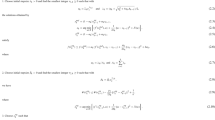Abstract
This paper deals with some problems of algorithmic complexity arising when solving convex programming problems by following the path of analytic centers (i.e., the trajectory formed by the minimizers of the logarithmic barrier function). We prove that in the case ofm convex quadratic constraints we can obtain in a simple constructive way a two-sided ellipsoidal approximation for the feasible set (intersection ofm ellipsoids), whose tightness depends only onm. This can be used for the early identification of those constraints which are active at the optimum, and it also explains the efficiency of Newton's method used as a corrector when following the central path. Various parametrizations of the central path are studied. This also leads to an extrapolation (predictor) algorithm which can be regarded as a generalization of the method of conjugate gradients.
Similar content being viewed by others
References
Baker, G. A., P. Graves-Morris: Essentials of Padé Approximation. Encyclopedia of Mathematics, Vols. 13 and 14. Reading, Mass.: Addison Wesley, 1981.
Bayer, D. A., J. C. Lagarias: Karmarkar's linear programming algorithm and Newton's method. Preprint, AT&T Bell Laboratories, Murray Hill, N.J., 1987.
Cybenko, G.: Restrictions of normal operators, Padé approximation and autoregressive time series. SIAM J. Math. Anal. 15:753–767 (1984).
Fiacco, A. V.: Introduction to Sensitivity and Stability Analysis in Nonlinear Programming. New York: Academic Press, 1983.
Gilewicz, J., et al. (eds.): Rational Approximation and Its Applications in Mathematics and Physics. Lecture Notes in Mathematics, Vol. 1237. Berlin: Springer-Verlag, 1986.
Huard, P., B. T. Liêu: La méthode des centres dans un espace topologique. Numer. Math. 8:56–67 (1966).
Iri, M., H. Imai: A multiplicative penalty function. Algorithmica 1:455–482 (1986).
Jarre, F.: On the convergence of the method of analytic centers when applied to convex quadratic programs. Technical Report No. 41, Schwerpunktprogramm Anwendungsbezogene Optimierung und Steuerung, Institut für Angewandte Mathematik und Statistik, Universität Würzburg, 1988, submitted to Math. Programming.
Jarre, F., Gy. Sonnevend, J. Stoer: An implementation of the method of analytic centers. In: Lecture Notes in Control and Information Sciences, Vol. 111 (A. Bensoussan, J. L. Lions, eds.), pp. 297–307. Berlin: Springer-Verlag, 1988.
Karmarkar, N.: A new polynomial time algorithm for linear programming. Combinatorica 4:373–395 (1984).
Kojima, M., S. Mizuno, A. Yoshishe: A polynomial-time algorithm for a class of linear complementarity problems. Research Report NO B-193, Department of Information Sciences, Tokyo Institute of Technology, Meguro, Tokyo 152, 1987.
Renegar, J.: A polynomial-time algorithm based on Newton's method for linear programming. Report MSRI 07 118-86, Mathematical Sciences Research Institute, Berkeley, Calif., 1986.
Sonnevend, Gy.: Sequential, stable and low complexity methods for the solution of moment (mass recovery) problems. Colloquia Mathematica Societatis János Bolyai, Vol. 50. Numerical Methods (Miskolc 1986), pp. 635–667. Budapest: Akademia; Amsterdam: North Holland, 1987.
Sonnevend, Gy.: An analytic center for polyhedrons and new classes of global algorithms for linear (smooth convex) programming. In: Lecture Notes in Control and Information Sciences, Vol. 84, pp. 866–876. Berlin: Springer-Verlag, 1985.
Sonnevend, Gy.: New algorithms in convex programming based on a notion of “centre” (for systems of analytic inequalities) and on rational extrapolation. In: Trends in Mathematical Optimization (K. H. Hoffmann, J. Zowe, eds.), ISNM, Vol. 84, pp. 311–327. Basel: Birkhäuser, 1988.
Todd, M. J.: Improved bounds and containing ellipsoids in Karmarkar's linear programming algorithm. Technical Report No. 721, School of Operations Research, Cornell University, Ithaka, N.J., 1986.
Vaidya, P. M.: An algorithm for linear programming which requiresO(((m + n)n 2+(m + n) 1.5)L) arithmetic operations. Preprint, AT&T Bell Laboratories, Murray Hill, N.J., 1987.
Ye, Y., M. Todd: Containing and shrinking ellipsoids in the path-following algorithm. Manuscript, Oct. 1987, Stanford University. To appear in Math. Programming.
Ye, Y.: Interior algorithms for linear, quadratic, and linearly constrained convex programming. Ph.D. Thesis, Department of Engineering and Economic Systems, Stanford University, Stanford, Calif., 1987.
Author information
Authors and Affiliations
Additional information
This research was supported by the Deutsche Forschungsgemeinschaft as part of a major research project “Anwendungsbezogene Optimierung und Steuerung.”
Rights and permissions
About this article
Cite this article
Sonnevend, G., Stoer, J. Global ellipsoidal approximations and homotopy methods for solving convex analytic programs. Appl Math Optim 21, 139–165 (1990). https://doi.org/10.1007/BF01445161
Accepted:
Published:
Issue Date:
DOI: https://doi.org/10.1007/BF01445161



